Wine Tourism in Burgundy
Explore the treasures of the Côte de Beaune wine region
RESTAURANTS
Chassagne Montrachet : EDEM : 1 star
Puligny Montrachet :
- LE MONTRACHET
- L’ESTAMINET
- KLIMA
- LE BISTRO D'OLIVIER
Chagny :
- LAMELOISE : 3 stars
- LE GRENIER A SEL
Remigny : L’ESCALE
Santenay :
- L’OUILLETTE
- LE TERROIR
Photo credit : Arts & Gastronomie
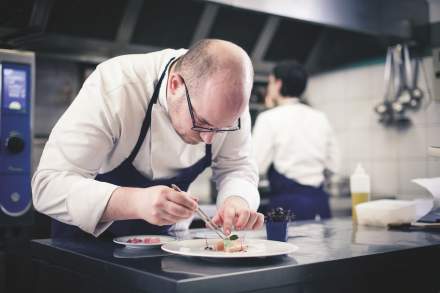
Beaune
The Hôtel Dieu, the Notre Dame Collegiate Church, the Ramparts
Seat of parliament in the Middle Ages and residence of the Dukes of Burgundy until the 14th century, Beaune is today the capital of Burgundy wines, situated in the heart of the vineyards. It is also designated a ‘Town of Art and History’ with a rich historic and architectural heritage. This town, full of charm, is renowned for its Hôtel Dieu, its Notre-Dame Collegiate Church, and also for its world-famous Wine Auction held on the third Sunday in November.
The Hôtel Dieu
The veritable jewel in the crown of Beaune, the Hôtel Dieu cannot fail to impress with its stunning architecture, its history, its collection of 5,000 precious objects and its celebrated altarpiece, a polyptych of the Last Judgement painted by Rogier van der Weyden. It was built in 1443 by the couple Nicolas Rolin (Philippe le Bon’s Chancellor) and Guigone de Salins during a tragic period of famine and plague. This medieval building looked after the poor and the sick up until 1971, when a modern hospital was constructed. With its colored glazed tiles, it is the most beautiful and iconic monument in Beaune.
It is possible to visit:
- The “chambre des pôvres” or hospital room for the poor. This immense space (50 meters long, 14 meters wide and 16 meters high) contains 28 canopy beds with red dividing curtains and is of unique architecture in the shape of an upturned hull of a boat, decorated with multicolored sea monsters representing hell, and tiles engraved with the initials of Nicolas Rolin and Guigone de Salins and the word « Seulle » as a mark of the Chancellor’s devotion to his wife.
- The Chapel. Its position adjoining the salle des pôvres allowed the sick to take part in religious services without needing to leave the hospital.
- Sainte-Anne’s room, which was reserved for nobles.
- Saint-Hugues’ room containing the paintings of Isaac Moillon illustrating the miracles of Christ.
- Saint-Nicolas’ room, which was the former infirmary for those close to death.
- The kitchen with its monumental gothic double fireplace and automatic roasting spit.
- The pharmacy and apothecary.
- The hall containing the famous polyptych of the Last Judgement, masterpiece of Flemish art by the artist Rogier Van der Weyden.
- The room of Saint-Louis and the Tapestries of Tournai (early 16th century) and Brussels (end 16th century).
The Notre Dame Collegiate Church
Constructed in the 12th century, this is one of the last great churches of Burgundian Romanesque architecture. Begun in 1120, it was not finished until around a century later, and despite additions over the centuries still conserves a remarkable stylistic harmony.
It is known as the “daughter of Cluny” because it is constructed following the Cluny model and was inspired by the Cathedral Saint-Lazare d’Autun. It has been listed as a Historic Monument since 1840, and its presbytery since 1926. It is possible to visit the transept, part of the 13th century cloister, and the chapter house.
It houses a collection of tapestries that mark the passage from the art of the Middle Ages to that of the Renaissance. Situated by the high altar, these are nineteen scenes, woven in wool and silk, illustrating the life of the Virgin Mary.
The ramparts
The ramparts that are visible today were built in the 17th century, with eight bulwarks remaining from the 15th century. They served to ensure the defense the town. You can walk around the ramparts (2 km) and admire various landmarks of the city of Beaune, the vineyards, and the Montagne de Beaune.
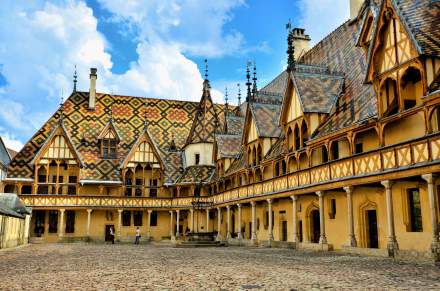
Saint-Aubin
Saint Aubin is a charming village surrounded by exceptional vineyards. Its slopes adjoin the gems of the Côte de Beaune : Meursault, Puligny-Montrachet and Chassagne-Montrachet.
It is constructed around a 10th century Carolingian church, just a step away from the Château. The main street of the village follows the ancient route of a Roman road.
photo credit : Prosper Maufoux
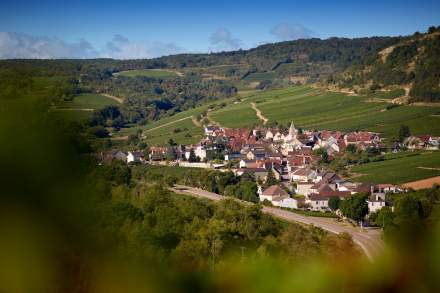
The Hamlet of Gamay
Gamay, a delightful hamlet of Saint-Aubin, nestles at the end of a valley. It is a well-preserved architectural ensemble that includes a 10th and 11th century fortified house with a courtyard, enclosure, dungeon, dovecote, and moat. This noble residence was restored at the end of the 19th century.
photo credit : Torsade de Pointes
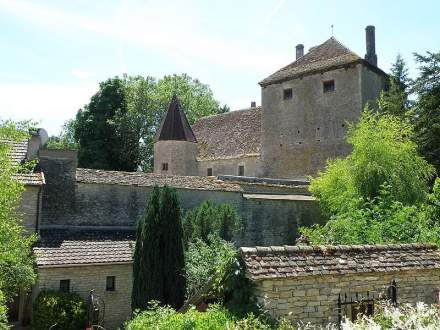
La Rochepot
Le Rochepot is a winemaking village that produces Hautes Côtes de Beaune. It is dominated by its superb 13th century château with colored roof tiles, perched on a rocky outcrop. A terrace in the courtyard offers a fabulous panorama over the village and surrounding hills.
Dolmens and long barrows attest to the occupation of the site in the Neolithic period. Also worth seeing is the 12th century church of Saint Georges.
photo credit : Prosper Maufoux
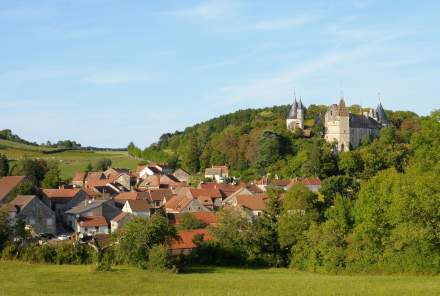
Château de Corabeuf
Halfway between Beaune and Chagny, Puligny-Montrachet produces wines that Alexandre Dumas said should be drunk "on your knees and with your head uncovered", in particular 4 of its grands crus, Montrachet and Bâtard-Montrachet (shared with Chassagne-Montrachet) Chevalier-Montrachet and Bienvenüe-Bâtard-Montrachet. To be discovered in the cellars or on the "Balade en Montrachet" walking tour.
photo credit : Puligny-Montrachet
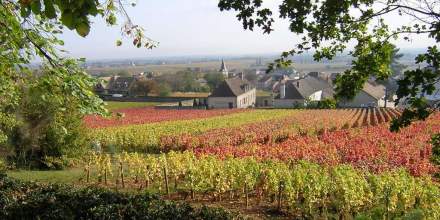
NOLAY
The medieval city of Nolay is 60 km from Dijon and 18 km from Beaune in the department of the Côte d'Or.
Built on the site of a Gallo Roman settlement, it became a prosperous town at the intersection of two economic sectors: agriculture and viticulture. Today it is an attractive market town which offers the pleasure of exploring its narrow medieval streets of half-timbered houses, its 14th century stone-roofed market hall, and its 15th and 17th century church. A town steeped in history which has succeeded in combining modernity with a preserved heritage.
photo credit : Beaune Tourisme
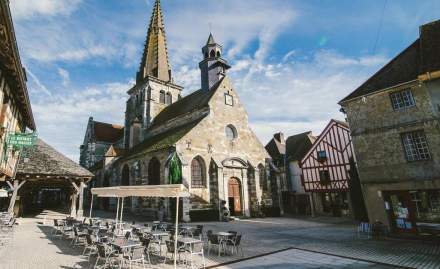
CHAGNY
Between the Côte Chalonnaise and the Côte de Beaune, Chagny is a centre for green tourism and gastronomy. Discover its rich cultural heritage, the Green Way that runs alongside the Canal du Centre, and its many footpaths amongst the vineyards and hillsides.
Restaurant Lameloise: 3 Michelin stars.
Don’t miss the local farmers’ market on Sunday mornings.
photo credit : Julien Piffaut
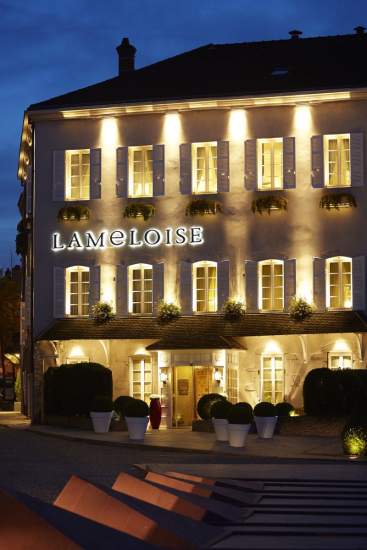
Chalon-sur-Saône
Museum, Cathedral, markets...
The Nicéphore Niépce Museum
The Nicéphore Niépce museum at Chalon-sur-Saône is located in the old Hôtel des Messageries Royales, constructed in around 1750 facing the Saône. Although it bears the name of the inventor of photography, it is not exclusively dedicated to him, but rather a generic museum of photography, that follows the evolution of photography from its birth in the 19th century up to the present day. The museum covers every aspect of this art, from the heliographs of Niépce to the first color photographs of Louis Ducos du Hauron (1868), the daguerreotype to the ferrotype (photographs on metal made by travelling photographers of the 19th century), from the argentic to the numeric, Pictorialism to French Humanism of the fifties and the modern New Vision movement of the thirties, and from street to studio.
The greatest names in photography have been exhibited here: Robert Doisneau, Edouard Boubat, Lucien Clergue, Bernard Plossu, Sabine Weiss, Peter Knapp, Malick Sidibé...
The Cathedral Saint Vincent
The historic cathedral Saint Vincent is the major edifice of the medieval town center, situated on the most animated square in the heart of the old town. Designated an Historic Monument in 1903, it is the ancient sanctuary of the Bishop of Chalon. Constructed between 1090 and 1522, it combines the characteristics of both Roman and Gothic Art. The square, with its many superb timbered houses, is the ideal spot to stroll or enjoy the sun on a café terrace, and profit from the magnificent view of the impeccably restored cathedral.
Place Saint Vincent market
The market on the Place Saint Vincent takes place every Friday (all day) and on Sunday (mornings). Here, at the foot of the cathedral, some 100 market holders enliven the streets of the historic center with their wares: clothes, table linen, leather goods, shoes, fabrics, hats, umbrellas, cosmetics, jewelry and knick-knacks, as well as fruit and vegetables, cheeses, poultry, fish and kitchenware.
The market, which is a veritable institution in the town, has been held here for over 1,200 years.
photo credit : Ludovic Courtès
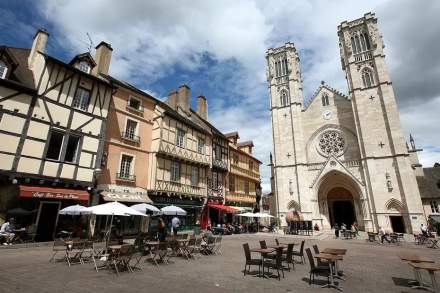
The JOA casino at Santenay
Slot machines, roulette ...
The Joa casino at Santenay opens its doors to you in the Côte de Beaune, in an old manor house in the heart of the vines, which was specially renovated for the purpose.
It proposes more than 150 slot machines, games of English and French roulette, blackjack, and Texas hold'em poker. The casino has its own restaurant, but there are two others on the village square: Le Terroir and L’Ouillette
photo credit : Casino Joa Santenay

CHATEAU DE GERMOLLES
Deep in the Burgundy countryside, not far from Chalon-sur-Saône, the Château de Germolles is today the best-preserved example of a residence of the Dukes of Burgundy.
First a fortified barn and later a defensive castle in the 12th and 13th centuries, it was gifted by the Duke of Burgundy, Philipppe le Hardi, to his wife Marguerite de Flandre at the end of the 14th century. She completely transformed this simple building into a luxurious manor house, thanks to the work of gifted artists such as Claus Sluter and Jean de Beaumetz.
Its architecture and sumptuous decors and its bucolic environment make this a remarkable and original site that bears witness to the splendor of courtly life on the eve of the Renaissance.
Visit the château and its park for a fascinating voyage into history.
photo credit : Christian Degrigny
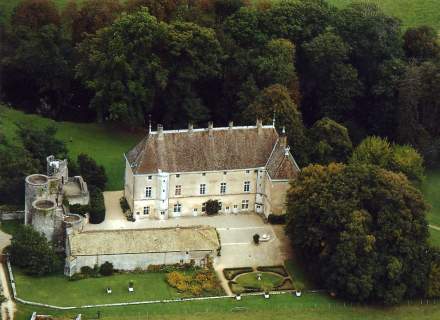
The Mountain of the Three Crosses
A breathtaking view from the summit!
The Mont de Sène, familiarly known as the ‘mountain of the 3 crosses’ culminates at 521 meters, dominating the valley of Santenay, and offering an incredible 360° view of its vineyards and the environs: the hills of the Côte de Beaune, the Saône valley and the first foothills of the Jura mountains, the Clunisois, Mount Saint-Vincent, the Morvan, and last but not least, Mount Beuvray.
The presence of several dolmens and a temple dedicated to Mercury show that the Mont de Sène was occupied by man in ancient times. The three crosses (triple crucifix), erected on the summit in the 19th century, replaced a 17th century crucifix.
The Mont de Sène has been designated a Natural Park since 1993, and is covered in a wide variety of wild plants and bushes. It is accessible only on foot.

Cycling
Through the heart of the vineyards
The 22 km long cycle path between Santenay and Beaune offers the opportunity to ride through the prestigious appellations of the Côte de Beaune such as Beaune, Pommard, Volnay, Meursault, Puligny-Montrachet, Chassagne-Montrachet and Santenay. Or you can take the Green Way towards Chalon sur Saône or the canal du Centre.
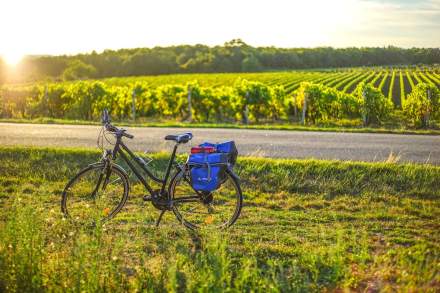
Epicurean Visits
Gourmet Burgundy!
Veuve Ambal
Experience the creation of a Crémant de Bourgogne… live!!
A fascinating tour for all the family, thanks to a walkway that looks down on the different stages of production, where you can learn all about how Crémant de Bourgogne is made.
As well as this guided visit, you can participate in a commented tasting of the three Veuve Ambal Crémants (or non-alcoholic drinks for the under 18s) in the boutique/tasting room.
www.veuveambal.com
Anis de Flavigny
Welcome to Aniseed country, welcome to Flavigny!
The secret hidden in the heart of our sweets? The tiny seed of the aniseed plant. It’s a story that has endured for centuries. Find out all about it during a free visit. For our opening hours call :
03.80.96.20.88
www.anisdeflavigny.com
Mulot & PetitJean
Established in 1796, Mulot & Petitjean perpetuate the skills of the gingerbread makers of Dijon. Two sites that will evoke the gourmandize of childhood :
- The original shop in the Hôtel Catin de Richemont. Learn about the history and traditions of gingerbread and how it is made.
- The production site. A themed tour of the site of almost 450 m²... Discover the history of Mulot & Petitjean and of Dijon gingerbread. Follow the different stages of gingerbread making and try the various specialties at a tasting in the boutique area.
https://www.mulotpetitjean.com/#musee
Fromagerie Gaugry
The Gaugry family, cheesemakers since 1946, invite you to share their passion, their knowledge and experience. From the special viewing gallery you can watch cheeses like Epoisses, l'Ami du Chambertin, and many others, being made.
www.gaugryfromager.com
Cassissium
Discover the secrets of making crème de cassis during a guided visit to the Vedrenne production facility. Museum and multimedia space.
Tasting of crème de cassis, liqueurs, Burgundian aperitifs, eaux de vie... and a choice of 40 flavors of syrup!
www.cassissium.com
Moutarderie FALLOT
Learn all about mustard, thanks to two fun, interactive circuits at the Moutarderie Fallot.
- The Discovery circuit based on the traditions and history of mustard making.
- The Intense Sensations circuit focused on contemporary mustard making methods.
L'Or des Valois
Established in the outbuildings of the Château d'Entre-Deux-Monts, l'Or des Valois propose a workshop on the theme of trufficulture. While the dogs are at work, they will explain the biological cycle of this amazing fungus, the truffle, and how a truffle-field is managed.
The owner of the château will present the history of the site and the architecture of the building, which was constructed between the 13th and 17th centuries. The workshop will conclude with a truffle tasting or sampling of products made with Burgundy truffles sold in the Or des Valois boutique.
photo credit : Maison Veuve Ambal

The Canal and its Green Way
A Nautical Halt
The Canal du Centre was built between 1783 and 1793 by the engineer Emiland Gauthey. This waterway was designed to link the Mediterranean to the Atlantic and played an important role in the growth of local industry. For the Blanzy-Montceau mining basin and the Schneider-Creusot factories, it served as a supply route for raw materials and for transporting finished goods.
After the Second World War it was converted to leisure navigation, and you can now sail via the Saône and Loire, to the Atlantic, the English Channel, the Mediterranean and even eastern Europe, via the Rhine.
The Green Way runs alongside the Canal du Centre for 33km from Saint Léger sur Dheune to Chalon sur Saône. Many leisure boats use this canal, appreciated for its diversity of landscapes, which you can enjoy by bicycle by following the Green Way.
From Saint Aubin it is easy to reach Santenay, Remigny and Chagny.
If you wish, you can prolong your ride from Givry to Cluny (44 km) and then from Cluny to Charnay-lès-Mâcon (20 km), via the old railway line.
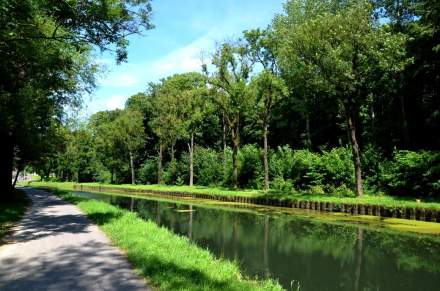
AUTUN
Or Augustodonum, Rome’s little sister, at 45 minutes drive from Saint Aubin. Designated a Town of Art and History, with an exceptional architectural heritage, its origins can be traced back over 2,000 years, and it is the premier Gallo-roman site north of the Loire.
- Temple of Janus
- Porte de l’Arroux
- Roman theatre
Medieval
- The cathedral of Saint Lazare, affiliated to the Order of Cluny. Its construction began in 1120. The sculptures of the artist Gilbertus, tympanum and capitals, are exceptional.
- The area around the cathedral, which has preserved its medieval character with timbered houses and narrow streets.
- The Rolin Museum, former home of the family of Nicolas Rolin, Chancellor to the Duke of Burgundy Philippe le Bon and the founder of the celebrated Hospices de Beaune
and …………….
The Ancient Jesuits College where Napoléon was educated (now the Lycée Bonaparte).
Talleyrand was Bishop of Autun.
A huge seminary with a roof of glazed tiles was built at the end of the 18th century. Since 1884 it has been a Military Lycee
The Town Hall, the Italian style theatre on the ‘Champ de Mars’ and a charming covered passage date from the 19th century.
photo credit : Ville d'Autin

BIBRACTE – MOUNT BEUVRAY
An archeological site and museum designated a ‘Grand Site de France’
Founded at the summit of Mount Beuvray by the Aeduan people at the end of the 11th century BC, this site was to become their capital. Occupied by Caesar, this is a remarkable and incredibly well-preserved oppidum, with visible ramparts and vestiges covering 200 hectares.
photo credit : Bibracte - Antoine Maillier
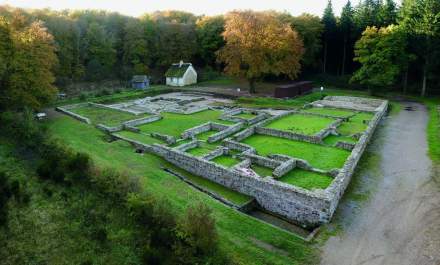
FESTIVALS
In the Côte Chalonnaise at Givry at the end of June - Musicaves
Couches, at the beginning of July - Jazz at Couches
Beaune, every Friday/Saturday/Sunday of July . Festival Baroque and Romantic
Saint Sernin du Plain, end of July - Les Nuits du Mont Rome
Chagny, end of August - Les Moments Musicaux
End of August - Musicales of the Côte chalonnaise (Buxy and around)
photo credit : Festival Les Nuits du Mont Rome




